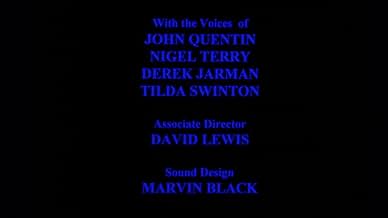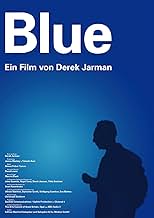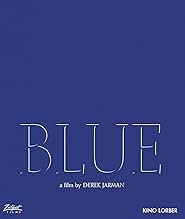Aggiungi una trama nella tua linguaIn his final - and most daring - cinematic statement, Jarman the romantic meets Jarman the iconoclast in a lush soundscape pulsing against a purely blue screen, laying bare his physical and ... Leggi tuttoIn his final - and most daring - cinematic statement, Jarman the romantic meets Jarman the iconoclast in a lush soundscape pulsing against a purely blue screen, laying bare his physical and spiritual state.In his final - and most daring - cinematic statement, Jarman the romantic meets Jarman the iconoclast in a lush soundscape pulsing against a purely blue screen, laying bare his physical and spiritual state.
- Regia
- Sceneggiatura
- Star
- Premi
- 2 vittorie e 1 candidatura in totale
- Self
- (voce)
- …
- Narrator
- (voce)
- Narrator
- (voce)
- Narrator
- (voce)
Recensioni in evidenza
feature in which his diaristic reminiscences, and commentary on
his current degeneration from AIDS symptoms, are set against a
placid musical score and a cool, empty blue background.
An obviously simple idea, but what an amazingly rich one: Jarman
has created the closest movie experience to a director talking to
the inside of your head. The concomitant feelings of control-losing
peace and terrifying hallucination (one obviously starts to project
images into the blue blankness) are...well, so obviously apt, aren't
they? For a film about spirit, and about the interiorness of
everyone's reactions, BLUE is remarkably controlled in its effects.
It provides an experience adult viewers haven't had much since
childhood--of letting go and getting lost.
If you did see this on a big screen, however, you were sure to notice the tricks your eyes played on you. Jarman, directing this film as he lost his eyesight (and what could be worse for a director?), last saw the color blue. As you watch the film, your eyes become saturated with the color blue, and begin to try and compensate for the overstimulation, shifting to oranges, showing illusionary shapes in the blank field of the screen, and ultimately betraying you. What better allegory for the loss of one's vision, especially when it means everything to you?
There's a good deal of spoken word, often poetic, and sometimes quite moving. Some of the snippets of music used here are also fantastic- not sure if they were sampled and if so where from, but they added a lot.
Despite the short length, had put off watching this for a while because I wasn't sure I was ever in the right mood for something this different and challenging. Even tonight, it wasn't the perfect movie for this very day, but at least now I'll know what to expect, and can maybe return to it on a day when I'm feeling like I could connect to it more.
But for the parts that did get to me, and the fact that it was an experiment that was mostly pulled off very well, a good deal of credit must be given.
Jarman's story is one that does not need visuals to support it. Reflecting upon his life in the face of his rapidly approaching death, Jarman's memories and meditations offer the viewer (listener, really) a window into the soul of a director who is losing the most important sense he could posses: his sight. Blue was the last color available to him before AIDS related complications robbed him of his sight. As he stands before death and stares it straight in the face, Jarman's writings put forth a suprising feeling of calmness, as he has accepted his own finitude and shares his meditations with us in this, his last masterpiece.
Lo sapevi?
- QuizDerek Jarman went completely blind as a side effect of AIDS which is why this film is audio based. He died the year after its production.
- Citazioni
Terry, Nigel: We've always been mistreated and the moment anyone gives us the slightest bit of attention we over-react with our thanks.
- ConnessioniFeatured in Derek Jarman: Life as Art (2004)
I più visti
- How long is Blue?Powered by Alexa
Dettagli
Botteghino
- Budget
- 90.000 £ (previsto)
- Tempo di esecuzione
- 1h 19min(79 min)
- Mix di suoni
- Proporzioni
- 1.85 : 1
























